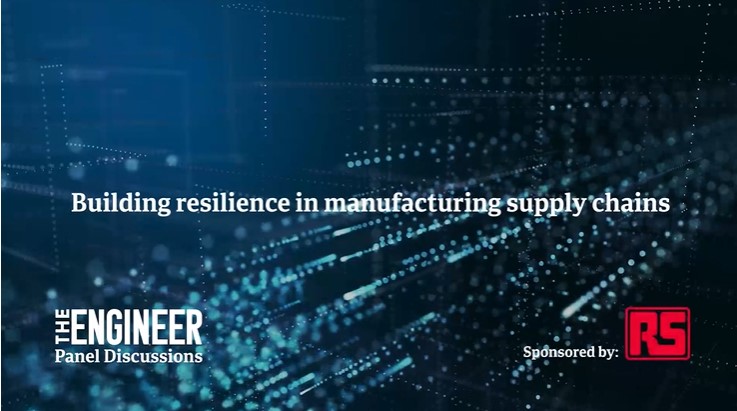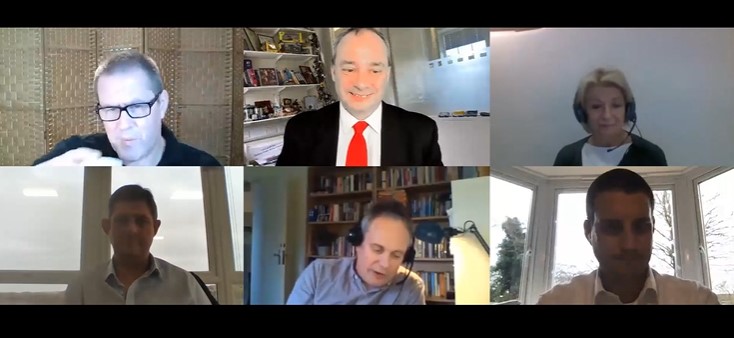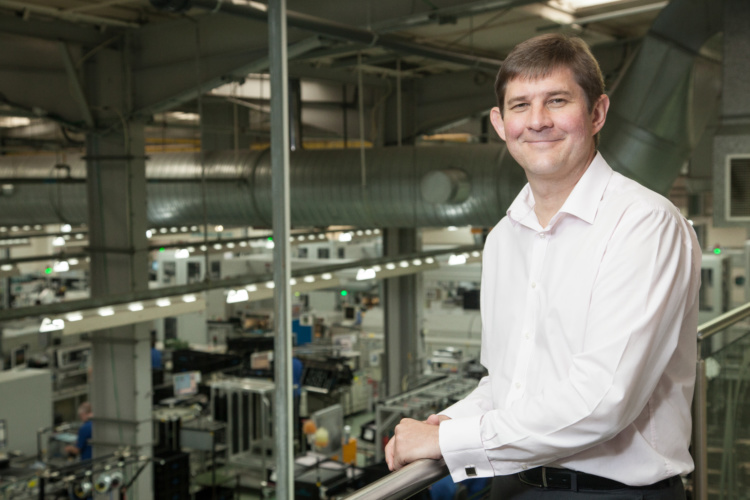
The events of the past 12 months - coupled with challenges related to the UK’s new trading relationship with the EU - have highlighted both the critical importance, and the frailties of manufacturing supply chains and have prompted organisations across a range of sectors to rethink their strategies.
Last year (December 2020)- in partnership with leading industrial components supplier RS components - The Engineer brought together a panel of experts to explore the latest thinking around manufacturing supply chain management and examine some of the measures that can be taken to manage risks and disruption in the short term and build in resilience for the long term.
The following report examines some of the key topics explored during this discussion
Meet the panel
- Professor Richard Wilding OBE - Professor in Supply Chain Strategy, Cranfield School of Management UK
- Julia Moore - Chief Executive GTMA / Reshoring UK
- Richard Jeffers – Director, Industrial Digital Solutions, RS Components
- Andrew Peters – Managing Director of Siemens Digital Industries, Congleton
- Paul Kilmister - Head of Airframe Supply Management, Airbus UK
Setting the scene
 Opening the discussion, one of the world’s leading authorities on logistics and supply chain management, Cranfield School of Management’s Professor Richard Wilding, offered a pithy description of what supply chain resilience actually means in practice.
Opening the discussion, one of the world’s leading authorities on logistics and supply chain management, Cranfield School of Management’s Professor Richard Wilding, offered a pithy description of what supply chain resilience actually means in practice.
It is, he said, all about being prepared for unexpected events; being able to respond to disruption; and being able to rapidly recover.
The need for this kind of resilience has - he said - become increasingly critical in the face of ever more complex global supply chain challenges. And whilst supply chain management used to be primarily about ensuring a focus on predictability, efficiency and cost reduction, he explained that we have now entered the world of the “bi-modal supply chain”, where alongside this traditional focus, organisations need to take an iterative and adaptive approach that enables them to deal with the unexpected.
The impact of the current pandemic has, he said, accelerated this thinking: “Post COVID-19 The emphasis will shift towards resilience rather than cost, we’re finding a reassessment of the flows across the supply chains.”
Outlining a framework he uses to help businesses ensure that they are doing both, Wilding said that the starting point is ensuring that you have a coherent understanding of your supply chain strategy, that you truly understand what’s creating value for your customers and that you design a supply chain around that.
Post COVID-19 The emphasis will shift towards resilience rather than cost, we’re finding a reassessment of the flows across the supply chains
There are then a number of elements that are key to delivering on your strategy, he explained. Businesses must – for instance - embrace a culture where people actively think about the supply chain, and pursue a relentless focus on agility.
For manufacturers, it’s also critically important that product design and supply chain management are aligned. “You build a lot of the risk into the supply chain at the design phase….having the design of the product and the design of the supply chain running concurrently can help mitigate an awful lot of the risk,” he said.
Another key pillar is supply chain collaboration, he added, noting that the businesses he works with that have performed most resiliently in recent months are those able to manage relationships effectively. Warning that organisations shouldn’t expect this to happen organically he said: “achieving this requires organisations to put in clear performance measures, resource and processes for managing relationships.”
The final element, he said, is ensuring that there is transparency in the supply chain, by using digital tools to pick up on potential disruptions and enable supply chain professionals to react accordingly
A supplier perspective
 Our next panelist, RS Components’ director of industrial digital solutions Richard Jeffers, outlined how his own organisation - a major part of many supply chains - is putting some of these ideas into practice.
Our next panelist, RS Components’ director of industrial digital solutions Richard Jeffers, outlined how his own organisation - a major part of many supply chains - is putting some of these ideas into practice.
From an RS perspective, one of the keys to maintaining critical supply chains is, he said, the strength of the relationships the company has with its suppliers and its customers. Jeffers explained that by truly understanding its customers needs and working closely with its army of 2.5k suppliers, RS is able to ensure that inventory is exactly where it needs to be, when it needs to be there.
Alongside a broad and resilient supplier base, he said that the organisation also ensures it always has plenty of inventory in stock. “We hold 500,000 different SKUs (stock keeping units) within our system across multiple locations and that gives the opportunity to flex the supply. When you’ve got problems in one geography you can source that product from another geography.”
Drawing on his experience of the past 12 months Jeffers echoed Wilding’s comments on the way in which supply chain priorities are shifting. “Once in a lifetime events are happening with increasing frequency and understanding the real risk assessment of your supply chain - and where the vulnerability is - is something that’s going to have to become more and more important to people’s procurement decisions,” he said.
Meeting the COVID challenge
 At this point, discussion turned to one of 2020’s manufacturing high points; the Ventilator Challenge UK project, which - back in March 2020 - brought together a consortium of leading UK engineering firms to produce medical ventilators for the UK.
At this point, discussion turned to one of 2020’s manufacturing high points; the Ventilator Challenge UK project, which - back in March 2020 - brought together a consortium of leading UK engineering firms to produce medical ventilators for the UK.
Unsurprisingly, setting up a new production line for a new product in the middle of a global lockdown presented some particularly intense supply chain challenges, and our next panelist, Airbus’ Paul Kilmister, explained how the consortium addressed some of these challenges and how the lessons learned are feeding back into industry.
Kilmister, whose usual role is heading up airframe supply at Airbus’ Broughton facility, explained how, for an intense couple of months, he stepped away from the world of aircraft wings and found himself “running blue watch” on the ventilator challenge supply chain, ensuring that the consortium could manufacture the required devices twentyfour seven.
Whilst a number of useful lessons were learned from the project, Kilmister said it’s important to recognise that some of the factors that drove the project’s success are impossible to replicate: in particular the “wartime spirit” of the engineers involved, who were, he said, energised by a sense that this was industry’s moment to rise the challenge of a national crisis.

Despite this, there are some key supply chain learnings that consortium members have taken from the project, one of which – he said - is the value of incorporating in-service feedback into supply chain management. “As the disease was progressing we got incredible in service feedback, and that meant that we were able to adapt and modify the design. This reaction kept our product current.”
The project – which saw the development of a bespoke enterprise resource planning (ERP) also gave consortium members some valuable insights into how cloud based ERP can be used to enhance agility. Indeed, Kilmister said the experience has helped advance Airbus’ thinking in this area.
Finally, referencing Prof Wilding’s point on the importance of collaboration, Kilmister said that the diversity of companies in the consortium, and the way in which this helped drive its success, provided all involved with a reminder of the huge value of cross sector collaboration.
Reshoring the supply chain
 Our next speaker was GTMA and Reshoring UK CEO Julia Moore, who turned her attention the way in which reshoring - a trend that has been gathering momentum in recent years - can help boost resilience.
Our next speaker was GTMA and Reshoring UK CEO Julia Moore, who turned her attention the way in which reshoring - a trend that has been gathering momentum in recent years - can help boost resilience.
Moore began by talking about the often overlooked capabilities of UK manufacturing SMEs and how the many companies populating this diverse chunk of the engineering landscape boast many of the qualities that are critical to supporting future proof supply chains. “They provide the innovation, flexible working practices, agility and adaptiability, and ability to cross industry sectors,” she said.
Moore explained how the objective of Reshoring UK is to help provide greater visibility of these pockets of UK expertise, so that manufacturing companies can tap into talent closer to home, and overcome some of the challenges presented by increasingly complex and fragmented global supply chains.
She added that although there are now a number of examples of firms reshoring elements of projects, there are too many examples of UK companies overlooking the UK manufacturing base and made a passionate plea for more government support to encourage manufacturers to manufacture in the UK. “Government needs to incentivise UK manufacturers to seek UK suppliers,” she said.
The digital supply chain
 Our final speaker - Andrew Peters - joined us from one of the UK’s most sophisticated and productive manufacturing facilities: Siemens’ Congleton plant, which produces variable speed drives and controls for customers around the world.
Our final speaker - Andrew Peters - joined us from one of the UK’s most sophisticated and productive manufacturing facilities: Siemens’ Congleton plant, which produces variable speed drives and controls for customers around the world.
Peters, MD of the facility, explained how innovation in supply chain management has been key to enabling the company to meet increasingly varied customer requirements and shift from supplying a standard stocked product from a catalogue to supplying a product with 50,000 variations that could be manufactured next day.
Digitalisation has clearly been at the heart of this, and Congleton is today celebrated as one of the UK’s few true Industry 4.0 facilities, but Peters cautioned that digitalisation is only effective if the underpinning processes are efficient to start with. “Everything we’ve done on digital is only to do with taking good processes, and removing waste and inefficiency and then digitalisation.”
Peters went onto explain how digitalisation has been key to enabling the facility to react to (and plan for) disruptive situations in the supply chain. “We simulated the entire end to end supply chain taking in all of the suppliers and their sub suppliers and figuring out what were the single points of failure. We then injected some disruptive scenarios and that enabled us to work out the right level of stock and contingency.”
“What it’s not about is trying to take your supply chain on a journey to make them great,” he cautioned, “It’s too big a challenge. You’ve got to take what you’ve got and design something that works for you.”
If UK manufacturing can get anywhere close to mastering this it’ll give us a unique competitive advantage over many other countries
One of the keys to achieving this, he added, is looking at ways of overcoming the challenges presented by disparate systems. “Every day I see companies with disparate systems (ERP, MES, Scheduling systems, forecast tools etc.) and the way they’ve managed for the last 20 years is with great people. But if you’re trying to do something to deliver to the customer the next day it doesn’t give you the level of standardisation and consistency you need. We’ve done things like low code applications where you start to draw information from disparate systems so you can start to give transparency to the situation and this allows you to solve problems before they happen.”
Developing this kind of reactive, agile capability across UK manufacturing will, he concluded, be key to growing a competitive edge in the years ahead.
“How do we get from being great reacting and managing situations to heading those situations off before they happen? If UK manufacturing can get anywhere close to mastering this it’ll give us a unique competitive advantage over many other countries.”
Watch a full recording of this session below:




Poll: Should the UK’s railways be renationalised?
Rail passenger numbers declined from 1.27 million in 1946 to 735,000 in 1994 a fall of 42% over 49 years. In 2019 the last pre-Covid year the number...